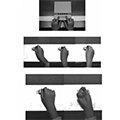Abstract
When lateralized responses are made to the locations of vertically arrayed stimuli, two types of mapping effect have been reported: an overall up–right/down–left advantage and mapping preferences that vary with response position. According to Cho and Proctor’s (2003) multiple asymmetric codes account, these orthogonal stimulus–response compatibility effects are due to the correspondence of stimulus polarity and response polarity, as determined by the positions relative to multiple frames of reference. The present study examined these two types of orthogonal compatibility for situations in which participants made left–right responses to the colours of a vertically arrayed stimulus set, and stimulus location was irrelevant. Although a significant orthogonal Simon effect was not evident when responding at a centred, neutral response position, the effect was modulated by response eccentricity (Experiment 2) and hand posture (Experiment 3). These effects are qualitatively similar to those obtained when stimulus location is task relevant. The results imply that, as Proctor and Cho’s (2006) polarity correspondence principle suggests, the stimulus polarity code activates the response code of corresponding polarity even when stimulus location is irrelevant to the task.
